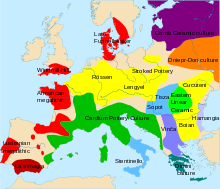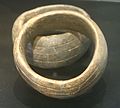
The term Danubian culture was coined by the Australian archaeologist Vere Gordon Childe to describe the first agrarian society in Central Europe and Eastern Europe. It covers the Linear Pottery culture, stroked pottery and Rössen cultures.
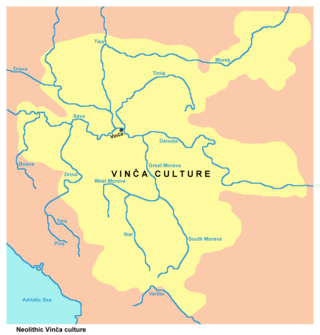
The Vinča culture (ʋîːntʃa), also known as Turdaș culture, Turdaș–Vinča culture or Vinča-Turdaș culture, is a Neolithic archaeological culture of Southeast Europe, dated to the period 5400–4500 BC. Named for its type site, Vinča-Belo Brdo, a large tell settlement discovered by Serbian archaeologist Miloje Vasić in 1908, it represents the material remains of a prehistoric society mainly distinguished by its settlement pattern and ritual behaviour.

The Únětice culture, Aunjetitz culture or Unetician culture is an archaeological culture at the start of the Central European Bronze Age, dated roughly to about 2300–1600 BC. The eponymous site for this culture, the village of Únětice, is located in the central Czech Republic, northwest of Prague. There are about 1,400 documented Únětice culture sites in the Czech Republic and Slovakia, 550 sites in Poland, and, in Germany, about 500 sites and loose finds locations. The Únětice culture is also known from north-eastern Austria, and from western Ukraine.

Bylany is a Danubian Neolithic archaeological site located around 65 km (40 mi) east of Prague in the Czech region of Bohemia. Excavation began in 1955 and work continues today.
Old Europe is a term coined by the Lithuanian archaeologist Marija Gimbutas to describe what she perceived as a relatively homogeneous pre-Indo-European Neolithic and Copper Age culture or civilisation in Southeast Europe, centred in the Lower Danube Valley. Old Europe is also referred to in some literature as the Danube civilisation.
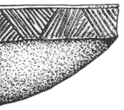
Unstan ware is the name used by archaeologists for a type of finely made and decorated Neolithic pottery from the 4th and 3rd millennia BC. Typical are elegant and distinctive shallow bowls with a band of grooved patterning below the rim, a type of decoration which was created using a technique known as "stab-and-drag". A second version consists of undecorated, round-bottomed bowls. Some of the bowls had bits of volcanic rock included in the clay to make them stronger. Bone tools were used to burnish the surfaces to make them shiny and impermeable.

The Funnel(-neck-)beaker culture, in short TRB or TBK, was an archaeological culture in north-central Europe. It developed as a technological merger of local neolithic and mesolithic techno-complexes between the lower Elbe and middle Vistula rivers. These predecessors were the (Danubian) Lengyel-influenced Stroke-ornamented ware culture (STK) groups/Late Lengyel and Baden-Boleráz in the southeast, Rössen groups in the southwest and the Ertebølle-Ellerbek groups in the north. The TRB introduced farming and husbandry as major food sources to the pottery-using hunter-gatherers north of this line.

The Lengyel culture is an archaeological culture of the European Neolithic, centered on the Middle Danube in Central Europe. It flourished from 5000 to 4000 BC, ending with phase IV, e.g., in Bohemia represented by the 'Jordanow/Jordansmühler culture'. It is followed by the Funnelbeaker culture/TrB culture and the Baden culture. The eponymous type site is at Lengyel in Tolna county, Hungary.
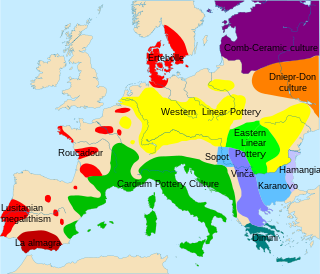
The Hamangia culture is a Late Neolithic archaeological culture of Dobruja between the Danube and the Black Sea and Muntenia in the south. It is named after the site of Baia-Hamangia, discovered in 1952 along Golovița Lake.

Cardium pottery or Cardial ware is a Neolithic decorative style that gets its name from the imprinting of the clay with the heart-shaped shell of the Corculum cardissa, a member of the cockle family Cardiidae. These forms of pottery are in turn used to define the Neolithic culture which produced and spread them, commonly called the "Cardial culture".

Approximately 120–150 Neolithic earthworks enclosures are known in Central Europe. They are called Kreisgrabenanlagen in German, or alternatively as roundels. They are mostly confined to the Elbe and Danube basins, in modern-day Germany, Austria, Czech Republic, Slovakia, as well as the adjacent parts of Hungary and Poland, in a stretch of Central European land some 800 km (500 mi) across. They date to the first half of the 5th millennium BC; they are associated with the late Linear Pottery culture and its local successors, the Stroke-ornamented ware and Lengyel cultures. The best known and oldest of these Circular Enclosures is the Goseck circle, constructed c. 4900 BC.

Pottery in the Indian subcontinent has an ancient history and is one of the most tangible and iconic elements of Indian art. Evidence of pottery has been found in the early settlements of Lahuradewa and later the Indus Valley Civilisation. Today, it is a cultural art that is still practiced extensively in the subcontinent. Until recent times all Indian pottery has been earthenware, including terracotta.

In the archaeology of Southwest Asia, the Late Neolithic, also known as the Ceramic Neolithic or Pottery Neolithic, is the final part of the Neolithic period, following on from the Pre-Pottery Neolithic and preceding the Chalcolithic. It is sometimes further divided into Pottery Neolithic A (PNA) and Pottery Neolithic B (PNB) phases.

The Stone Age in the territory of present-day Poland is divided into the Paleolithic, Mesolithic, and Neolithic eras. The Paleolithic extended from about 500,000 BCE to 8000 BCE. The Paleolithic is subdivided into periods, the Lower Paleolithic, 500,000 to 350,000 BCE, the Middle Paleolithic, 350,000 to 40,000 BCE, the Upper Paleolithic, 40,000 to 10,000 BCE, and the Final Paleolithic, 10,000 to 8000 BCE. The Mesolithic lasted from 8000 to 5500 BCE, and the Neolithic from 5500 to 2300 BCE. The Neolithic is subdivided into the Neolithic proper, 5500 to 2900 BCE, and the Copper Age, 2900 to 2300 BCE.
Ceramic petrography is a laboratory-based scientific archaeological technique that examines the mineralogical and microstructural composition of ceramics and other inorganic materials under the polarised light microscope in order to interpret aspects of the provenance and technology of artefacts.

The Hassuna culture is a Neolithic archaeological culture in northern Mesopotamia dating to the early sixth millennium BC. It is named after the type site of Tell Hassuna in Iraq. Other sites where Hassuna material has been found include Tell Shemshara.

The Boian culture, also known as the Giulești–Marița culture or Marița culture, is a Neolithic archaeological culture of Southeast Europe. It is primarily found along the lower course of the Danube in what is now Romania and Bulgaria, and thus may be considered a Danubian culture.

Romanian archaeology begins in the 19th century.

The Linear Pottery culture (LBK) is a major archaeological horizon of the European Neolithic period, flourishing c. 5500–4500 BC. Derived from the German Linearbandkeramik, it is also known as the Linear Band Ware, Linear Ware, Linear Ceramics or Incised Ware culture, falling within the Danubian I culture of V. Gordon Childe.

Romanian art consists of the visual and plastic arts originating from the geographical area of Romania. The production of art in Romania is as old as the Paleolithic, an example being a cave painting from the Cuciulat Cave. During the Neolithic, multiple cultures lived on the modern territory of Romania. Their material culture included pottery and abstract clay statuettes decorated with geometric patterns. These may give hints on the way these civilizations used to dress and maybe tattoo. A good examples of this is the Thinker of Hamangia, a clay figurine produced by the Hamangia culture. Important cultures of the Neolithic era include Starčevo–Körös–Criș, Boian, Gumelnița–Karanovo, and other ones, the most famous and at the same time the most evolved among them in art being the Cucuteni–Trypillia culture. During Antiquity, the Geto-Dacians produced art and built multiple cities of the dava type. Greek colonies appear in Dobruja, including Tomis, and Mangalia. After the Dacian Wars, Emperor Trajan transformed a big part of Dacia into a province of the Roman Empire. The province underwent an intense process of Romanization.
